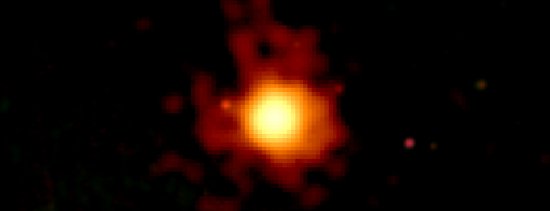29
GRB 090423
Posted by jns on April 29, 2009
This luminous blob is a “gamma-ray burster”, and exceedingly distant from us: slightly over 13 billion light-years. In fact, it is the current record-holder in the “most distant object seen” category. It was spotted recently by NASA’s Swift spacecraft (about the spacecraft; and about the Swift mission).
Just how a gamma-ray burst happens is still being studied — it’s a big reason behind the Swift mission. GRBs seem to be associated with star remnants collapsing into black holes following a supernova event.
Following the explosion of a big enough star (see “A Star Explodes in Slow Motion“), a shell of matter is expanding around a core that is collapsing into the singularity known as a black hole. In all likelihood this collapsing matter is rotating at very high velocity.
It is thought that lumps of matter falling into the black hole cause some matter to be ejected at very high velocity away from the center in a narrowly collimated jet at relativistic speeds. As this jet passes through the expanding shell of matter around the object, interactions between the jet and the shell of matter produce radiation across a wide spectrum but still in a narrowly visible cone. Sometimes we are fortunate that one of those cones is headed in our direction.
Of this event the NASA press release (“New Gamma-Ray Burst Smashes Cosmic Distance Record“; also source of the image above) says
April 28, 2009: NASA’s Swift satellite and an international team of astronomers have found a gamma-ray burst from a star that died when the universe was only 630 million years old–less than five percent of its present age. The event, dubbed GRB 090423, is the most distant cosmic explosion ever seen. [...]
The burst occurred at 3:55 a.m. EDT on April 23rd. Swift quickly pinpointed the explosion, allowing telescopes on Earth to target the burst before its afterglow faded away. Astronomers working in Chile and the Canary Islands independently measured the explosion’s redshift. It was 8.2, smashing the previous record of 6.7 set by an explosion in September 2008. A redshift of 8.2 corresponds to a distance of 13.035 billion light years.
“We’re seeing the demise of a star — and probably the birth of a black hole — in one of the universe’s earliest stellar generations,” says Derek Fox at Pennsylvania State University [where the flight operations staff is located].
That is incredibly far away!